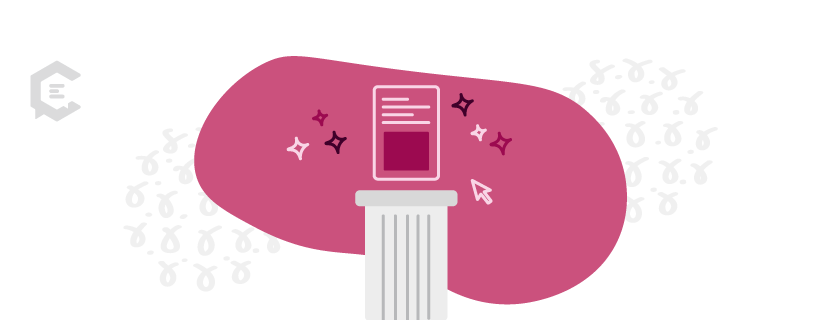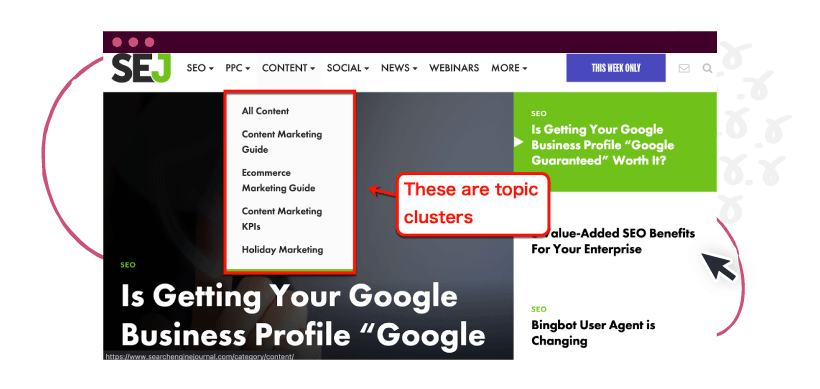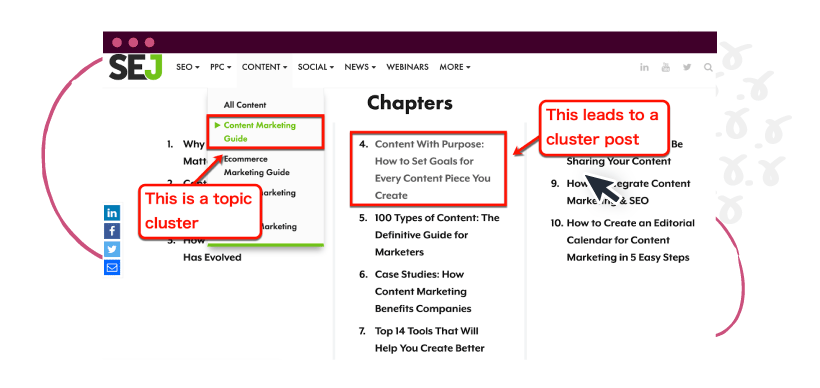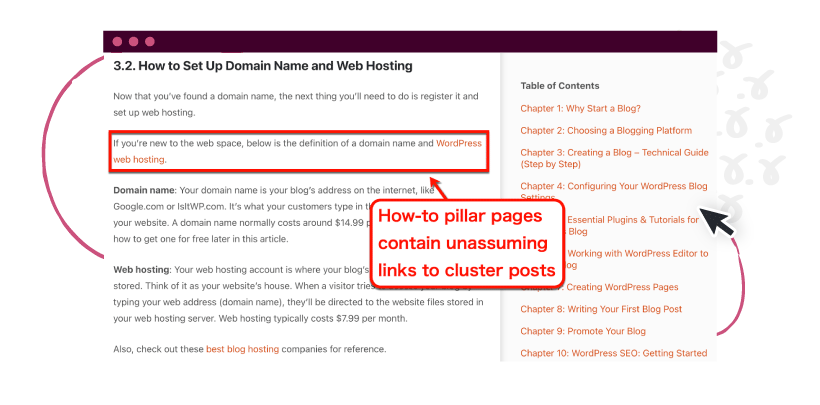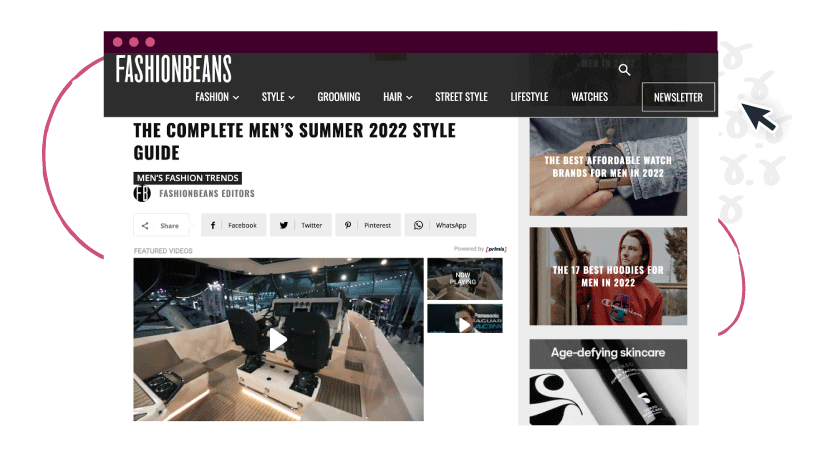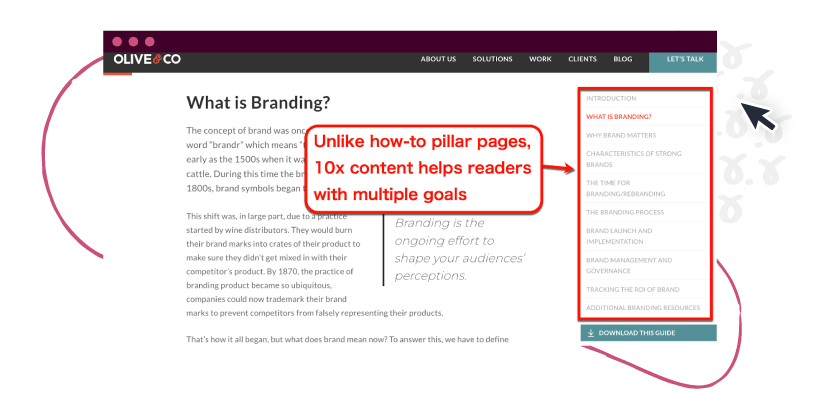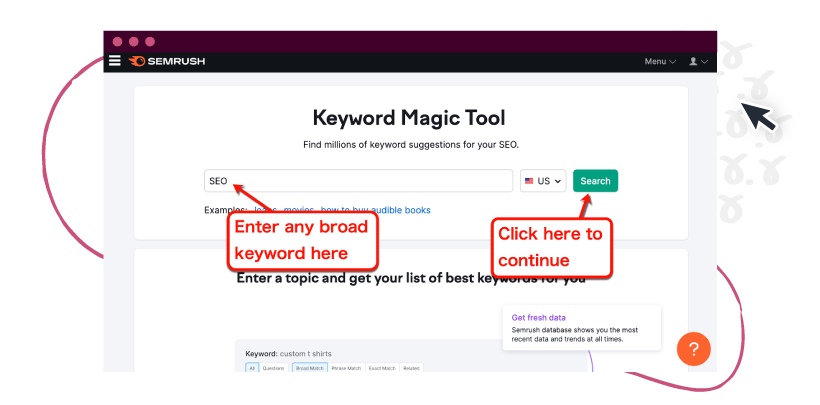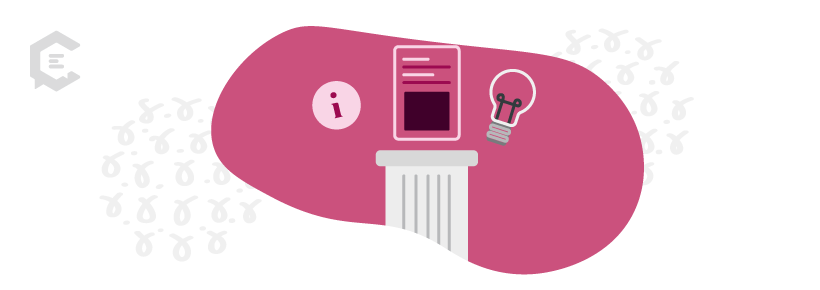Pillar pages are a smart way to supercharge your content strategy.
To build an SEO-friendly blog architecture, you need to group your blog topics and content pieces together in a strategic way. Doing so will make the lives of your content writers vastly easier, and it also improves user experience and your website’s rank-worthiness under Google’s gaze.
Cue pillar pages.
What is a pillar page?
A pillar page is a broad, comprehensive piece of content that briefly covers everything users want to know about the main topic.
It’s also sometimes referred to as long-form content or skyscraper content. Its defining feature is the set of internal links, which point to more specific posts that discuss subtopics.
Picture a tree with multiple branches shooting out from the central trunk — each branch laden with leaves. The trunk is the pillar page, whereas the numerous branches represent internal links. The leaves represent your website’s collection of in-depth content pieces.
For example, a pillar page can talk about “social media marketing” from a top-level perspective. This page has sections for subtopics, like Instagram marketing, Facebook advertising, TikTok tools, and so on.
Each section features a hyperlink that takes readers to a post discussing specific subtopics in greater detail. The leaves, in our illustration, are called “cluster posts.”
You now have the whole tree: the trunk (pillar page), branches (internal links), and leaves (cluster posts). This brings us to what the SEO community refers to as “topic clusters.”
What are topic clusters?
TL;DR: the topic cluster is the whole tree.
Most blogs focus on multiple topic clusters that encompass the broad topics they cover.
In many cases, topic clusters are reflected by the categories users find in the site’s primary navigation menu.
Image Source: SearchEngineJournal.com
In a sense, all topic clusters are post categories — but not all categories are topic clusters. The difference-maker here is the existence of a pillar page.
For example, Search Engine Journal uses pillars as the centerpiece of their topic clusters. If you click a category from the main menu, you’ll be redirected to a broad piece of content that links out to cluster posts.
Image Source: SearchEngineJournal.com
Some sites simply take you to a generic archive or category page when clicking a topic. SEO experts would be hard-pressed to call that cloud of related content a topic cluster without a pillar page to hold it all together.
Sure, these fragmented pieces of content may still link to each other. But without pillar pages and topic clusters in your site architecture, you miss out on the SEO benefits they bring.
What are the benefits of pillar pages for SEO?
Pillars on your website can drastically improve the user experience of your site visitors — and, by extension, your SEO. These pages serve as a convenient starting point for readers who want to do extensive research about a particular topic.
Rather than scrambling all over your site to look for relevant resources, all they have to do is find the right pillar.
Pillars with topic clusters in mind also make planning and creating content easier. If you create a pillar page for “email marketing,” you’ll naturally arrive at related cluster posts like:
- Email marketing tools
- Email marketing automation
- Retargeting strategies
- Creating drip campaigns
- Lead generation for email marketing
- Newsletter templates
Finally, topic clusters promote a healthy internal link profile that boosts the overall rank-worthiness of your website.
Remember, internal links not only point visitors to more posts. They also help search engine crawlers discover and index more content, understand the hierarchy of your pages, and spread link equity — all of which can increase site-wide rankings.
Types of pillar pages
It’s hard to define consistent pillar archetypes that every brand can use.
The thing is, brands like to add their own twist when putting together pillar pages. But if you scan a sufficient amount of pillars, you can recognize patterns that can be used to model pillar page strategies.
1. Brand-focused resource pages
A brand-focused resource page is a type of pillar that links to relevant resources from within the brand’s website. It is a simple piece of content that points to internal resources, including related blog posts, tools, landing pages, videos, and downloadable PDFs.
Resource pages are easy to create because they don’t need to stand by themselves. That means you don’t need to produce full-on content for the page.
In fact, most resource pages barely have any information. They survive with just a simple introduction and single paragraphs that describe the cluster posts. Here’s an example from Aha! Parenting:
Image Source: AhaParenting.com
2. The how-to pillar page
Some brands create pillars that look just like any other “how-to” guide.
Unlike resource pages, how-to pillar pages contain actual value in the form of basic information. They may include definitions of technical terms, tips, and step-by-step instructions.
Most importantly, how-to pillars contain links to more in-depth cluster posts.
A great example would be IsItWP’s pillar page on how to start a WordPress blog:
Image Source: IsItWP.com
Just remember that how-to pillar pages can be lengthy, especially if you’re tackling a complicated topic.
On the one hand, this makes how-to pillars do better SEO-wise — thanks to the number of keywords they include and the value they provide readers. Unfortunately, this also makes them much harder to create than other types, with the exception of 10x content pillar pages.
3. The 10x content pillar page
“10x content” is a term coined by Rand Fishkin in a Moz Whiteboard Friday post.
What is 10x content?
Simple: content that’s 10x better than your average content.
10x content is longer, more comprehensive, and packs significantly more actionable details than a typical blog post.
A 10x content pillar can be built around these principles. The key here is to uncover every question readers may have about a topic, and then cover those things thoroughly in a separate cluster post — or other pillar pages.
The main difference between 10x content pillars and how-to pillars is that the latter focus on related topics that relate to a single goal. 10x content pillar pages, on the other hand, cover multiple topics that involve different objectives.
For example, here’s a 10x content pillar from Olive & Company:
Image Source: OliveAndCompany.com
4. The product or service pillar page
This next pillar page type is built specifically for potential customers with strong purchase intent. It essentially functions as a buyer’s guide that can include the different product types, their benefits, pricing, and a couple of practical tips.
Take note that you can create product or service pillars even if you’re just an affiliate.
For example, FashionBeans published the product pillar post called The Complete Men’s Summer 2022 Style Guide.
Image Source: FashionBeans.com
The pillar’s primary topic, obviously, is men’s summer fashion. As for the topic cluster, FashionBeans covered the following:
- Easy summer outfits
- Summer wedding outfits
- Wearing sandals for every attire
- Manscaping
- Classic summer pieces
As you may have guessed, these cluster posts contain affiliate links that lead to products that FashionBeans promotes.
How to create pillar page content
Now that you understand the what’s and whys, it’s time for you to learn how to create a pillar page.
1. Focus on what your target audience wants
First things first, you need to come up with ideas for your pillar and topic clusters. The best way to do this is to start with your target audience’s goals. Do they want to learn link building? Are they looking for ways to get more traffic?
If so, “SEO” is a lucrative topic cluster opportunity for your brand. Established websites can use tools like Google Analytics to identify their most in-demand content and determine potential topic clusters.
For new websites that don’t have steady traffic, they can look at the topic clusters their top competitors are using.
2. Build a comprehensive keyword list
When it comes to pillars, keyword research tools like Semrush’s Keyword Magic Tool can help with two steps: discovering cluster topic ideas and researching keywords for cluster posts.
Enter a broad keyword that describes the topic cluster you want to use for your pillar.
Image Source: SEMrush.com
Pro tip: Click the ‘Questions’ tab to discover conversational search queries you can cover on your pillar page. This will help you find subtopics that your target audience actively looks for.
If you want to build a pillar, try to collect as many related keywords as possible. More importantly, look for long-tail queries or keyword variations for each subtopic you find. Don’t forget to include metrics like keyword difficulty, traffic, and CPC to help you decide which keywords to prioritize in each post.
3. Decide the best pillar page type to use
With your topic cluster and target keywords in hand, you now have everything you need to build a killer pillar page.
But first, you must decide the best pillar type to use for your topic cluster. Here are a few guidelines:
- Product or service pillar: Are you targeting keywords with purchase intent? Is your primary goal boosting profits?
- Brand-focused resource page: Do you want to put up a pillar page as fast as possible? Or does your blog already have loads of related content pieces?
- How-to pillar: Do you want your pillar page to help readers accomplish a specific goal? Are you targeting “how-to” keywords?
- 10x content pillar: Is your topic cluster broad or top-level? Do you want your pillar page to be as epic as possible?
4. Create your pillar page
Now you’re ready to build your pillar page. The most efficient approach here is to hire a content writing team to do it for you. It’s also wise to hire a pro to create a content strategy for topic clusters.
Keep in mind that, on top of your pillar content, you also need to produce cluster posts. These will be the posts that your pillar will link to.
If you want to do it yourself, here are the pillar page best practices to remember:
- Don’t cover everything to encourage readers to read cluster posts.
- Your pillar should include top-level stuff, like benefits, use cases, and quick tips.
- Make internal links stand out using “Read More” buttons or bigger fonts.
- Offer an option to download your pillar as a PDF.
- Use simple and consistent permalinks for pillar pages (i.e. www.yoursite.com/blog/pillar-topic).
- Add a table of contents to help readers find what they need.
- Make your pillar page as long as necessary — don’t skimp on word count.
- Target your pillar in link-building campaigns.
5 perfect pillar page examples
Need some more inspiration for your pillar? Check out these best pillar page examples from other brands:
- Learn SEO: an Introduction to Search Engine Optimization — Semrush
- How to Do Keyword Research for SEO — Ahrefs
- The Essential Guide to Inbound Marketing for HealthTech — Golden Spiral
- Life Insurance Buyer’s Guide — Quotacy
Frequently Asked Questions (FAQs) about pillar pages
Before we wrap things up, let’s discuss some FAQs about pillar pages and topic clusters.
1. Is a pillar page the same as a landing page?
Some landing pages may look like a pillar page with internal links to useful resources. But unlike landing pages, a pillar page is primarily designed for SEO and traffic generation—not conversions.
2. Why are topic clusters important in content marketing?
Topic clusters help brands create long-term content marketing plans that supply them with a large set of content ideas. They also help SEO and traffic spread by helping readers and search engine crawlers find more posts.
3. Is content repurposing part of the pillar content strategy?
Pillar pages may repurpose content from existing cluster posts, but it’s not a requirement. It will, however, allow brands to create pillar pages more efficiently while promoting more consistent messaging.
4. How to make your old content fresh again for SEO?
If you have a library of old posts that don’t get any traffic, use a pillar page to revive them. Simply insert internal links to your old posts and focus on promoting and ranking your pillar page.
Build a successful pillar content strategy today
You need a workforce to plan your topic cluster, build your pillar page, and write your cluster posts. ClearVoice proudly works with a large team of professional freelance writers experienced in these campaigns. Talk to a content specialist about developing pillar page content for your brand today.
